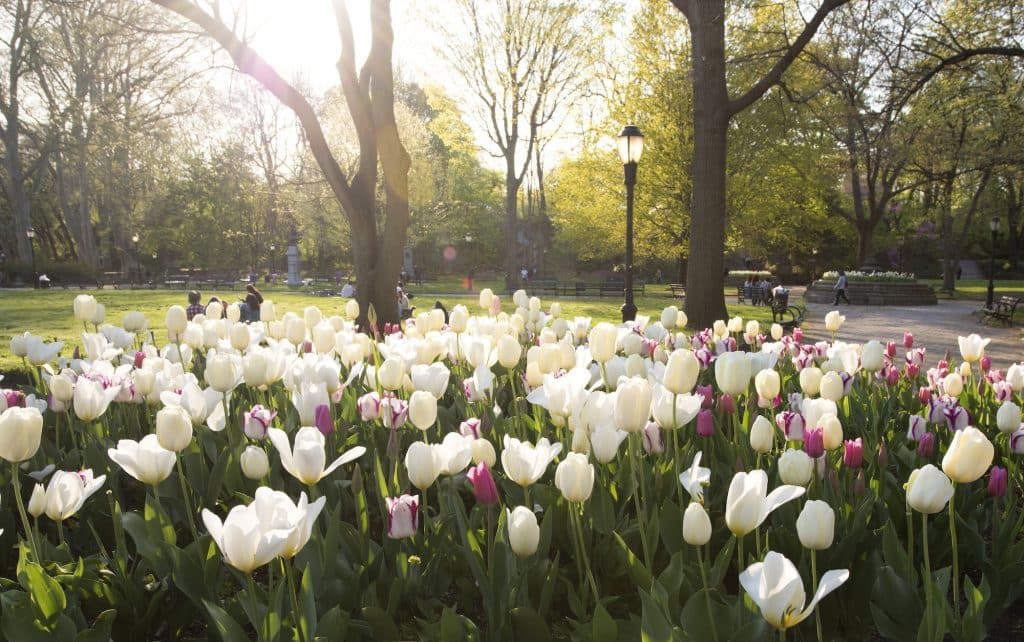Doctor’s Orders: A Walk in the Park
January 1, 2018
Should doctors be handing out prescriptions for a walk in the Park? Increasingly, studies suggest that a dose of nature does a body good. Bestselling author Florence Williams and New York Times health columnist Jane E. Brody report on the science behind what many of us know intuitively: that enjoying the outdoors makes us happier and healthier.
Luckily for those of us who live in Brooklyn, access to nature has been central to the development of our borough over a century. Chartered in 1834, Brooklyn became the nation’s third largest city within thirty years. The resulting crowds and unsanitary conditions prompted the first American attempts at urban planning, with public green space seen as a health necessity more than an aesthetic one. James T. Stranahan, a business and civic leader, spearheaded the creation of Prospect Park as head of the Brooklyn Parks Commissioners, overseeing the Park’s creation from inception to completion with designers Frederick Law Olmsted and Calvert Vaux. In the early 1860s, Stranahan argued that a park in Brooklyn “would become a favorite resort for all classes of our community, enabling thousands to enjoy pure air, with healthful exercise, at all seasons of the year…”
Today, Prospect Park’s lush 585 acres include 250 acres of woodlands—Brooklyn’s last remaining forest—and also the borough’s only lake, which are sustained by Prospect Park Alliance’s dedicated crews of horticulturalists, arborists and forest ecologists. Anyone who has explored one of the Park’s nature trails, or enjoyed a stroll along the watercourse, can attest to its restorative powers, but what is the science behind this?
For her new book Nature Fix: Why Nature Makes Us Happier, Healthier, and more Creative, Florence Williams traveled across the globe to report on cutting-edge studies that provide concrete links between exposure to nature and health. In one study, an Essex-based environmental economist launched an app that mapped participants’ happiness against their location and found that we are “significantly and substantially happier outdoors…” Further east in Japan, a team of researchers gathering statistical evidence to back up the Biophilia theory, which states that humans experience lower stress levels in nature because we evolved in the natural world. And in Utah, neuroscientists are quantifying how exposure to nature can increase cognitive sharpness and even combat attention disorders.
During her 42 years as the Personal Health Columnist at The New York Times, Jane E. Brody has regularly reported on how a lack of physical activity can cause a host of health issues including childhood obesity, type 2 diabetes, asthma, and vitamin D deficiency. She has linked these issues to a decline in time spent outdoors, warning against the dangers of “Outdoor Deprivation Disorder.” But, according to Brody, the benefits of outdoor activity are becoming more widely acknowledged throughout the medical community, “a growing number of like-minded doctors have begun writing specific prescriptions for outdoor activity.”
The conclusion seems simple–if modern scientific data tells us that getting outside is good for our health, then we should make a point to venture outdoors on a regular basis. In Nature Fix, Williams recommends getting “quick bursts” of the natural world, and where better to do this than in Brooklyn’s Backyard.
Join Prospect Park Alliance and its community partners for a variety of free and low-cost recreation and nature education activities year round. The Park boasts a 3.35-mile path for runners and bikers, the Long Meadow Ball Fields, the Parade Ground, the state-of-the-art LeFrak Center at Lakeside and a year-round Tennis Center. The Alliance also offers more than 800 public programs each year throughout the Park, which engage nearly 75,000 visitors. With so much exciting activity and stunning landscape, it is no wonder that the Park attracts more than 10 million visits each year.

